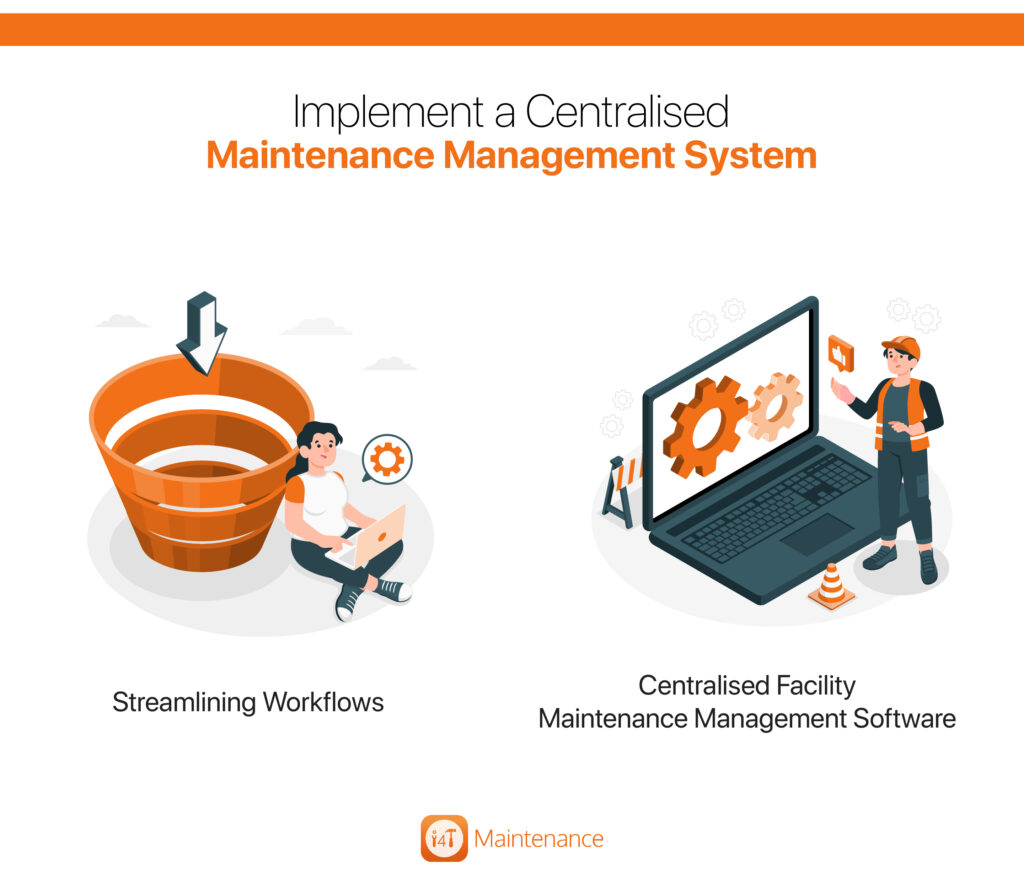Facilities maintenance management is more important than ever in Australia, with demand rising across commercial, industrial, and residential spaces.
From office buildings and factories to apartment complexes, keeping everything running smoothly is key to meeting today’s high standards for safety, efficiency, and sustainability.
Facility managers face the daily challenge of balancing costs with the need to keep buildings and equipment in top shape.
Facility maintenance management software has become a game-changer in this field. It helps facility managers stay organised by bringing all maintenance operations into one easy-to-use system. With this software, managing work orders, handling repair requests, tracking energy use, and keeping up with safety standards all become much simpler.
This blog will walk through some best practices in facilities management for Australian facility managers. By following these steps, managers can improve operations, reduce costs, and make sure assets last longer, all while staying ahead in today’s fast-paced world.
1. Implement a Centralised Maintenance Management System

Managing a facility means juggling a lot of tasks, from scheduling repairs and responding to tenant requests to keeping track of equipment health.
A centralised maintenance management system pulls all these tasks together in one place, making it easier for facility managers to stay on top of things. By using facility maintenance management software, you can view all maintenance activities from a single platform, helping you keep everything organised and running smoothly.
Streamlining Workflows
A centralised system makes it simple to handle work orders, track maintenance requests, and set task priorities. With everything in one spot, you can see what needs immediate attention, assign tasks to team members, and ensure work gets done on time. This streamlined setup cuts down on response times and makes sure tasks aren’t missed, keeping everything operating efficiently.
i4T Maintenance – Centralised Facility Maintenance Management Software
A good example is i4T Maintenance. This software brings together all the moving parts of facility maintenance into a single, easy-to-use platform. Facility managers using i4T Maintenance can get service requests, ask for supplier quotes, create work orders, track every maintenance request in real-time, and check progress all from one dashboard.
This means less time spent on paperwork and emails and more time focusing on getting things done, keeping both teams and tenants happy.
2. Emphasise Preventive and Predictive Maintenance
A big win in facilities management is focusing on preventive and predictive maintenance instead of only fixing things when they break.
Preventive maintenance means scheduling regular check-ups and servicing to catch problems early. Predictive maintenance goes a step further by using data to predict when equipment might need attention. Both approaches help prevent unexpected breakdowns and keep everything running smoothly.
Using Software for Maintenance Scheduling
With facility maintenance software, scheduling preventive maintenance becomes easy and automatic. You can set up reminders and plan regular check-ups for equipment like HVAC systems, lighting, and lifts. This way, everything gets maintained on schedule without you having to keep track manually. Automated scheduling lets you stay proactive, so your equipment gets the care it needs at the right time.
Benefits in Cost and Efficiency
A preventive approach saves money by reducing surprise repair costs and helping equipment last longer. When you keep up with regular maintenance, things like HVAC units and electrical systems work better and have fewer issues. This means less downtime, fewer repairs, and a smoother experience for everyone in the facility. In the long run, preventive maintenance is a simple way to boost efficiency and cut costs.
3. Focus on Sustainability and Energy Efficiency
Sustainability is becoming a big focus for facilities in Australia, as more places aim to be eco-friendly and energy-efficient. Facility managers have a great opportunity to help reduce environmental impact while also saving money by adopting greener practices.
This shift isn’t just good for the planet; it’s also a smart way to cut costs and stay in line with local regulations that support green initiatives.
Energy Tracking Features in Software
Facility maintenance software can help make buildings more energy-efficient. With the right software, you can monitor energy use, keep an eye on water consumption, and adjust lighting and HVAC systems to save power. This tracking makes it easy to spot areas where energy is being overused, so you can make changes that reduce waste and improve efficiency.
Benefits of Sustainable Practices
Eco-friendly practices come with lots of benefits! They help lower energy bills, keep your facility in line with Australia’s environmental rules, and boost your facility’s reputation. Tenants, employees, and visitors will notice your commitment to a greener future, which is great for your facility’s image. By focusing on sustainability, facility managers can help the planet while making their buildings more efficient and cost-effective.
4. Enhance Data-Driven Decision-Making
Good data is essential for making smart choices in facilities management. By collecting and looking at data, facility managers can see what’s working well and spot areas that need improvement. This data-driven approach helps managers stay proactive, catch small issues before they grow, and keep things running smoothly.
Software’s Role in Data Collection and Analysis
Facility maintenance software makes it easy to gather and understand data. With real-time insights and clear analytics, managers can track maintenance trends, monitor equipment health, and notice patterns over time. This way, they have a clear view of how well systems are working, which helps them make better decisions.
Example of Data-Driven Improvements
For instance, a facility manager might see from the data that a particular piece of equipment, like an HVAC unit, is breaking down more than others. This insight allows them to prioritise repairs or even plan for an upgrade, helping to prevent future issues. Using data to guide these choices helps reduce costs, improve reliability, and keep the facility running smoothly.
5. Establish Clear Communication Channels with Staff and Tenants
Good communication is essential in facility management. Facility managers, maintenance teams, and tenants all need to stay informed to keep things running smoothly. When everyone knows what’s going on, it’s easier to solve problems quickly, avoid confusion, and create a positive atmosphere.
How Facility Maintenance Software Helps with Communication
Facility maintenance software makes communication much easier. It provides real-time notifications, feedback channels, and updates on maintenance requests. Tenants can submit a request and get updates automatically, while managers can view requests instantly and assign them to the right team members. This way, everyone stays in the loop and knows what’s happening.
Impact on Tenant Satisfaction
Clear communication boosts tenant satisfaction. When tenants see their requests are being handled quickly and get regular updates, they feel valued and are less likely to raise repeated complaints. Proactive communication builds trust and keeps tenants happy, helping create a positive experience for everyone involved.
6. Ensure Compliance with Australian Standards and Regulations
Following Australian standards is a big part of facility management. Important regulations cover areas like safety, fire compliance, and environmental laws. Meeting these standards helps keep everyone safe, reduces risks, and keeps your facility running smoothly.
Compliance Tracking with Software
Facility maintenance software makes it easier to stay on top of compliance. It can track schedules, create reports, and organise all the documents you need for audits. You’ll get reminders for important tasks, like fire safety checks or equipment inspections, so nothing gets missed.
Benefits of Staying Compliant
Staying compliant has a lot of benefits. It helps avoid fines, keeps the building safe, and improves your facility’s reputation.
Tenants and visitors feel more secure knowing that safety and regulations are a top priority. Following these standards isn’t just about avoiding penalties, it’s about building trust and running a safe, reliable facility for everyone.
7. Optimise Inventory and Asset Management
Keeping track of equipment, spare parts, and other resources in a large facility can be challenging. Facility managers have to make sure everything is available when needed, without wasting space or money on extra supplies. This can be tricky, especially when managing a lot of items.
Inventory Management with Software
Facility maintenance software makes managing inventory and assets much easier. It can track inventory levels, set up automatic reordering, and give real-time updates on equipment conditions. For example, the software can alert you when stock is low and reorder parts automatically. It also keeps an eye on equipment health, helping you plan maintenance or replacements before things break down.
Cost Savings and Efficiency
Good inventory and asset management saves money by reducing downtime and preventing overstocking. When you have the right parts on hand and know the condition of the equipment, you avoid emergency repairs and keep operations running smoothly. This approach not only cuts costs but also makes life easier for facility managers by ensuring everything’s ready when needed.
8. Train Staff and Embrace Continuous Improvement
Regular training is essential for successful facilities management. Both facility managers and maintenance teams need ongoing training to keep up with new tools, software, and best practices. This helps everyone stay skilled, handle new challenges smoothly, and provide the best service possible.
Using Software for Training and Knowledge Sharing
Facility maintenance software can make training and knowledge-sharing easy. It can store manuals, schedule training sessions, and offer quick access to resources for building new skills. With everything in one place, staff can easily find what they need, saving time and making learning more convenient.
Embracing a Culture of Improvement
A focus on continuous improvement benefits everyone. By using data and feedback, facility managers can find ways to improve processes, making small changes that lead to big results. Encouraging learning and growth keeps the team engaged, helping the facility run better and building a team ready to adapt and improve over time.
Over to You
Following best practices like centralised maintenance, preventive care, sustainability, and using data helps make facilities run smoothly and efficiently.
By focusing on proactive maintenance, eco-friendly choices, and clear communication, facility managers can create a better experience for everyone.
Facility maintenance software in the market varies in the range and depth of these capabilities. Nonetheless, they play a great role in tying these practices together, making it easier to manage tasks, track progress, and stay organised. It’s a valuable tool for keeping operations on track and improving overall performance.
If you’re a facility manager looking to improve operations, now’s a great time to review your current practices and think about adopting maintenance software like i4T Maintenance.
It’s a simple step that can save time, cut costs, and add long-term value to your facility. Book a demo today.
FAQs
Maintenance software brings everything into one place, so facility managers can easily track repairs, requests, and upkeep. It helps keep buildings safe, efficient, and organised, saving time and reducing costs.
Preventive maintenance means checking things regularly to stop problems before they happen. Predictive maintenance uses data to predict when something might need fixing. Both help avoid unexpected breakdowns, save money, and keep the property running smoothly.
Maintenance software can track energy and water use, helping managers see where they can save power. By making small changes, managers can cut down on waste, save money, and make their buildings more eco-friendly.
Collecting data lets managers see patterns and notice what’s working or needs improvement. Using data makes it easier to plan repairs, prevent issues, and manage everything more smoothly
Maintenance software makes it simple to keep everyone in the loop. Tenants can easily request repairs and get updates, while managers can assign tasks quickly. Clear communication keeps tenants happy and the building running smoothly.

